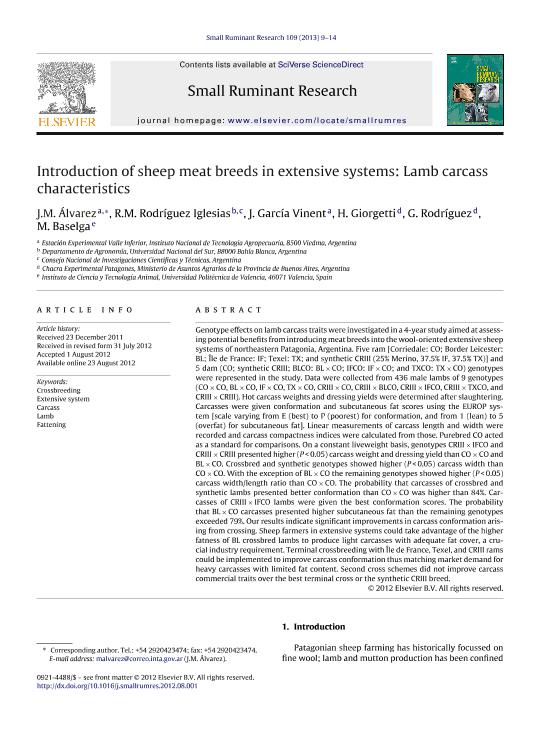Artículo
Introduction of Sheep Meat Breeds in Extensive Systems: Lamb Carcass Characteristics
Álvarez, J. M.; Rodriguez Iglesias, Ricardo Manuel ; García Vinent, J.; Giorgetti, H.; Rodriguez, Gisela Mariel
; García Vinent, J.; Giorgetti, H.; Rodriguez, Gisela Mariel ; Baselga, M.
; Baselga, M.
 ; García Vinent, J.; Giorgetti, H.; Rodriguez, Gisela Mariel
; García Vinent, J.; Giorgetti, H.; Rodriguez, Gisela Mariel ; Baselga, M.
; Baselga, M.
Fecha de publicación:
01/2013
Editorial:
Elsevier Science
Revista:
Journal Of Small Ruminant Research
ISSN:
0921-4488
Idioma:
Inglés
Tipo de recurso:
Artículo publicado
Clasificación temática:
Resumen
Genotype effects on lamb carcass traits were investigated in a 4-year study aimed at assessing potential benefits from introducing meat breeds into the wool-oriented extensive sheep systems of northeastern Patagonia, Argentina. Five ram [Corriedale: CO; Border Leicester: BL; Île de France: IF; Texel: TX; and synthetic CRIII (25% Merino, 37.5% IF, 37.5% TX)] and 5 dam (CO; synthetic CRIII; BLCO: BL × CO; IFCO: IF × CO; and TXCO: TX × CO) genotypes were represented in the study. Data were collected from 436 male lambs of 9 genotypes (CO × CO, BL × CO, IF × CO, TX × CO, CRIII × CO, CRIII × BLCO, CRIII × IFCO, CRIII × TXCO, and CRIII × CRIII). Hot carcass weights and dressing yields were determined after slaughtering. Carcasses were given conformation and subcutaneous fat scores using the EUROP system [scale varying from E (best) to P (poorest) for conformation, and from 1 (lean) to 5 (overfat) for subcutaneous fat]. Linear measurements of carcass length and width were recorded and carcass compactness indices were calculated from those. Purebred CO acted as a standard for comparisons. On a constant liveweight basis, genotypes CRIII × IFCO and CRIII × CRIII presented higher (P < 0.05) carcass weight and dressing yield than CO × CO and BL × CO. Crossbred and synthetic genotypes showed higher (P < 0.05) carcass width than CO × CO. With the exception of BL × CO the remaining genotypes showed higher (P < 0.05) carcass width/length ratio than CO × CO. The probability that carcasses of crossbred and synthetic lambs presented better conformation than CO × CO was higher than 84%. Carcasses of CRIII × IFCO lambs were given the best conformation scores. The probability that BL × CO carcasses presented higher subcutaneous fat than the remaining genotypes exceeded 79%. Our results indicate significant improvements in carcass conformation arising from crossing. Sheep farmers in extensive systems could take advantage of the higher fatness of BL crossbred lambs to produce light carcasses with adequate fat cover, a crucial industry requirement. Terminal crossbreeding with Île de France, Texel, and CRIII rams could be implemented to improve carcass conformation thus matching market demand for heavy carcasses with limited fat content. Second cross schemes did not improve carcass commercial traits over the best terminal cross or the synthetic CRIII breed.
Palabras clave:
Crossbreeding
,
Extensive System
,
Carcass
,
Lamb
,
Fattening
Archivos asociados
Licencia
Identificadores
Colecciones
Articulos(CCT - BAHIA BLANCA)
Articulos de CTRO.CIENTIFICO TECNOL.CONICET - BAHIA BLANCA
Articulos de CTRO.CIENTIFICO TECNOL.CONICET - BAHIA BLANCA
Citación
Álvarez, J. M.; Rodriguez Iglesias, Ricardo Manuel; García Vinent, J.; Giorgetti, H.; Rodriguez, Gisela Mariel; et al.; Introduction of Sheep Meat Breeds in Extensive Systems: Lamb Carcass Characteristics; Elsevier Science; Journal Of Small Ruminant Research; 109; 1; 1-2013; 9-14
Compartir
Altmétricas



